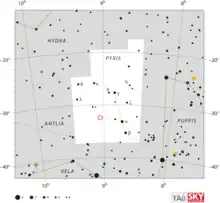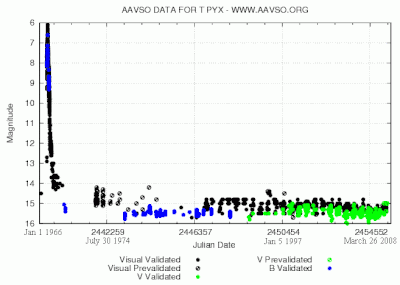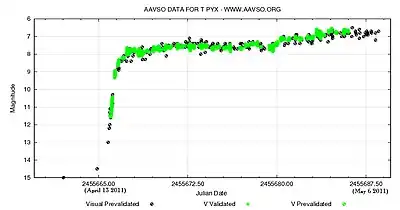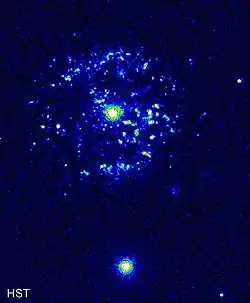| Observation data Epoch J2000 Equinox J2000 | |
|---|---|
| Constellation | Pyxis |
| Right ascension | 09h 04m 41.5062s[1] |
| Declination | −32° 22′ 47.5033″[1] |
| Apparent magnitude (V) | 6.4 Max. 18.5 Min.[2] |
| Characteristics | |
| Spectral type | White Dwarf |
| Variable type | Recurrent nova[2] |
| Astrometry | |
| Proper motion (μ) | RA: −2.531±0.052[1] mas/yr Dec.: 0.177±0.062[1] mas/yr |
| Parallax (π) | 0.3051 ± 0.0419 mas[1] |
| Distance | 3185+607 −283[2] pc |
| Details | |
| White dwarf | |
| Mass | 0.7±0.2 M☉ |
| Second component | |
| Mass | 0.14±0.03 M☉ |
| Orbit | |
| Period (P) | 1.8295 hours |
| Inclination (i) | 10±2° |
| Other designations | |
| Database references | |
| SIMBAD | data |

T Pyxidis (T Pyx)[4] is a recurrent nova[5] and nova remnant in the constellation Pyxis. It is a binary star system and its distance is estimated at about 4,783 parsecs (15,600 light-years) from Earth. It contains a Sun-like star and a white dwarf. Because of their close proximity and the larger mass of the white dwarf, the latter draws matter from the larger, less massive star. The influx of matter on the white dwarf's surface causes periodic thermonuclear explosions to occur.
The usual apparent magnitude of this star system is 15.5, but there have been observed eruptions with maximal apparent magnitude of about 7.0 in the years 1890, 1902, 1920, 1944, 1966 and 2011.[6] Evidence seems to indicate that T Pyxidis may have increased in mass despite the nova eruptions, and is now close to the Chandrasekhar limit when it might explode as a supernova.[7] When a white dwarf reaches this limit it will collapse under its own weight and cause a type Ia supernova.
Effect on Earth
Because of its relative proximity, some—in particular, Edward Sion, astronomer & astrophysicist at Villanova University, and his team therefrom—contend that a type 1a supernova could have a significant impact on Earth. The received gamma radiation would equal the total (all spectra) radiation of approximately 1,000 solar flares,[8] but the type Ia supernova would have to be closer than 1,000 parsecs (3,300 light-years) to cause significant damage to the ozone layer, and perhaps closer than 500 parsecs. The X-radiation that reaches Earth in such an event, however, would be less than the X-radiation of a single average solar flare.[8]
However, Sion's calculations were challenged by Alex Filippenko of the University of California at Berkeley who said that Sion had possibly miscalculated the damage that could be caused by a T Pyxidis supernova. He had used data for a far more deadly gamma-ray burst (GRB) occurring 1 kiloparsec from Earth, not a supernova, and T Pyxidis certainly is not expected to produce a GRB.[9] According to another expert, "[a] supernova would have to be 10 times closer [to Earth] to do the damage described."[9] Mankind survived when the radiation from the Crab Nebula supernova, at a distance of about 6,500 light-years, reached Earth in the year 1054. A type Ia supernova at a distance of 3,300 light-years would have an apparent magnitude of around -9.3, about as bright as the brightest Iridium (satellite) flares.[10]
Recent data indicates his distance estimate is five times too close. Astronomers used NASA's Hubble Space Telescope to observe the light emitted during its latest outburst in April 2011. The team also used the light echo to refine estimates of the nova's distance from Earth. The new distance is 15,600 light-years (4780 pc) from Earth. Previous estimates were between 6,500 and 16,000 light-years (2000 and 4900 pc).[11]
It has been reported that T Pyx would "soon" become a supernova.[7] However, when Scientific American contacted Sion, it became apparent that "soon" was meant in astronomical terms: Sion said that "soon" in the press announcement meant "[a]t the accretion rate we derived, the white dwarf in T Pyxidis will reach the Chandrasekhar Limit in ten million years."[12] By that time it will have moved far enough away from the Solar System to have little effect.

2011 outburst
Mike Linnolt detected T Pyx's first outburst in nearly 45 years on April 14, 2011 at magnitude 13.[13] According to AAVSO observers, it reached magnitude 7.5 in the visual and V bands by April 27,[14] and reached magnitude 6.8 by May 3.[15]

X-ray source
T Pyxidis is a super soft X-ray source.[16]
References
- 1 2 3 4 5 Brown, A. G. A.; et al. (Gaia collaboration) (August 2018). "Gaia Data Release 2: Summary of the contents and survey properties". Astronomy & Astrophysics. 616. A1. arXiv:1804.09365. Bibcode:2018A&A...616A...1G. doi:10.1051/0004-6361/201833051. Gaia DR2 record for this source at VizieR.
- 1 2 3 Schaefer, Bradley E. (2018). "The distances to Novae as seen by Gaia". Monthly Notices of the Royal Astronomical Society. 481 (3): 3033–3051. arXiv:1809.00180. Bibcode:2018MNRAS.481.3033S. doi:10.1093/mnras/sty2388. S2CID 118925493.
- ↑ "T Pyxidis". SIMBAD. Centre de données astronomiques de Strasbourg. Retrieved 2019-08-30.
- ↑ According to the Argelander system of nomenclature for variable stars, the initial letter is an R, and the counter progresses alphabetically. Thus, T Pyx is the third variable star in the constellation Pyx.
- ↑ Shara, Michael M.; Zurek, David R.; Williams, Robert E.; Prialnik, Dina; et al. (June 1997). "HST Imagery of the Non-Expanding, Clumped "Shell" of the Recurrent Nova T Pyxidis". Astronomical Journal. 114 (1): 258. Bibcode:1997AJ....114..258S. doi:10.1086/118470.
- ↑ "Outburst of the recurrent nova T Pyx". AAVSO. 2011.
- 1 2 "T Pyxidis Soon To Be A Type Ia Supernova". Space Daily. 2010-01-05. Retrieved 2010-01-05.
- 1 2 Richmond, Michael (5 December 2009). "Will a Nearby Supernova Endanger Life on Earth?". TASS, The Amateur Sky Survey. Archived from the original on 6 March 2007.
- 1 2 O'Neill, Ian (6 Jan 2010). "Will Earth 'Be Wiped Out' by a Supernova?". Discovery News.
- ↑ A type Ia supernova has an absolute magnitude of -19.3, which is how bright it would appear 10 parsecs away. This star is 3,300 ly (1000 pc) away, or roughly 100 times farther. By the inverse square law, it would thus appear 100^2 or 10,000 times dimmer. Each step of 5 magnitudes defined as a factor of 100 in brightness, so 10,000 times dimmer would be 10 magnitudes dimmer, or -9.3.
- ↑ Crotts, A.; Sokoloski, J.; Uthas, H. & Lawrence, S. (4 Jun 2013). "Hubble maps 3-D structure of ejected material around erupting star". NASA, ESA.
- ↑ "Supernova star too close for comfort". Scientific American. 5 Jan 2010.
- ↑ http://www.aavso.org/aavso-alert-notice-436 T Pyxidis has been discovered in outburst], 2011, AAVSO
- ↑ "T Pyxidis Finally Blows Again". Sky and Telescope. Retrieved April 30, 2011.
- ↑ "Sky & Telescope Observing Blog". Retrieved May 7, 2011.
- ↑ Ogley, R. N.; Chaty, S.; Crocker, M.; Eyres, S. P. S.; et al. (Apr 2002). "A search for radio emission from Galactic supersoft X-ray sources". Monthly Notices of the Royal Astronomical Society. 330 (4): 772–7. arXiv:astro-ph/0111120. Bibcode:2002MNRAS.330..772O. doi:10.1046/j.1365-8711.2002.05130.x. S2CID 3047485. Archived from the original on 2013-01-05.
External links
- AAVSO Variable Star Of The Month April, 2002: T Pyxidis PDF / HTML (17 July 2010)
- AAVSO: Quick Look View of AAVSO Observations (get recent magnitude estimates for T Pyx)
- Interview with Brad Schaefer about recurrent novae, and T Pyx (@19:40 into recording : 30 March 2009)
- Variable star T PYXIDIS
- Astronomers await a nova (Space.com 22 December 2006)
- Sion, Edward; A Supernova Could Nuke Us. Big Think.
- NASA Astronomy Picture of the Day: T Pyxidis: Recurrent Nova (25 September 1997)
- Explosive Nearby Star Could Threaten Earth
